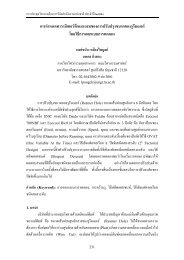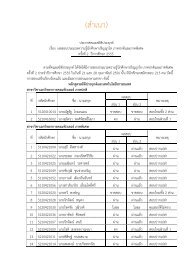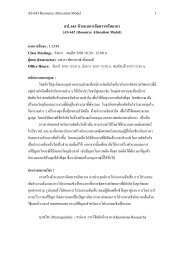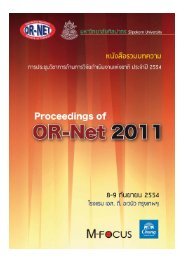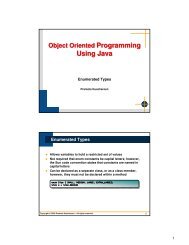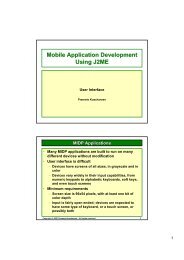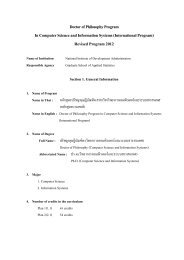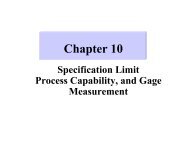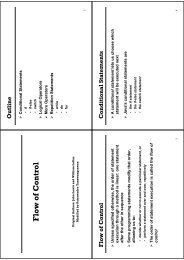B-19 - AS Nida
B-19 - AS Nida
B-19 - AS Nida
You also want an ePaper? Increase the reach of your titles
YUMPU automatically turns print PDFs into web optimized ePapers that Google loves.
Abstract<br />
In present, the healthcare services industry in Thailand is severely experiencing<br />
problems in inventory management, especially hospitals under the supervision of the<br />
government. Due to a high number of patients and limitations in resources such as<br />
personnel, storage space and importantly working procedures of the hospitals which<br />
impact to accuracy of medicines demand forecast and sufficiency of medicines, it can be<br />
result in high non-value-added inventory and high inventory management cost.<br />
This research aims to develop the pharmaceutical replenishment process for<br />
Vendor Managed Inventory system to suit any situations by implementing fuzzy logic<br />
model. Because the fuzzy logic can be simulating approximate to the decision from<br />
purchasing officer. It can also be prevent potential problems brought about by personnel<br />
turnover at the warehouse, and the subsequent loss of expertise and experience.<br />
This research reveals that the need for medical consumption has an enormous<br />
impact to decision-making in purchasing the medicines for replenishing one’s stock. From<br />
the research, it has been suggested to apply the winter's exponential smoothing method<br />
in forecasting for the future demand by using Ramathibodi hospital as a case study.<br />
Because pharmaceutical items as a key factor for replenishment process and subject to a<br />
degree of seasonality of demand, the researcher believed that the use of such techniques<br />
may provide a more accurate forecast for the items stocked by the central warehouse in<br />
the hospital.<br />
Keywords: medicines replenishment, usage rate, fuzzy logic, hospital, VMI<br />
1. บทน า<br />
ในปัจจุบันประเทศไทยก าลังเป็นที่จับตา<br />
มองและถูกยอมรับจากทั่วโลก<br />
ว่าเป็นประเทศที่มี<br />
ศักยภาพและความสามารถด้านการแพทย์ ทั้งใน<br />
ด้านความเชี่ยวชาญเฉพาะทางของบุคลากรและ<br />
คุณภาพการให้บริการในระดับมาตรฐานสากล<br />
สังเกตุได้จากการที่มีชาวต่างชาติเข้ามารับ<br />
บริการรักษาในประเทศอย่างต่อเนื่อง<br />
และมี<br />
จ านวนผู้เข้ามารับบริการสูงที่สุดในภูมิภาค<br />
เอเชีย สามารถน าเงินเข้าประเทศได้ไม่ต่ากว่าปี<br />
ละหมื่นล้านบาท<br />
(ส านักงานสถิติแห่งชาติ,2553)<br />
ดังนั้นรัฐบาลจึงเล็งเห็นถึงความส<br />
าคัญของ<br />
อุตสาหกรรมการให้บริการด้านสุขภาพ และได้มี<br />
นโยบายผลักดันให้ประเทศไทยกลายเป็นเมดิ<br />
คอลฮับของเอเชีย<br />
ในก า ร ศึ ก ษ า ส า ย โ ซ่ อุ ป ท า น ข อ ง<br />
โรงพยาบาล พบว่าส่วนที่ก่อให้เกิดภาระ<br />
ค่าใช้จ่ายที่ไม่สร้างมูลค่าแก่โรงพยาบาลสูงที่สุด<br />
ก็คือ ส่วนของสินค้าคงคลัง ซึ่งคิดโดยประมาณ<br />
17–35% ของรายได้ทั้งหมด<br />
เมื่อเปรียบเทียบกับ<br />
การบริหารจัดการในส่วนอื่นๆ<br />
[1] ดังนั้นนักวิจัย<br />
ส่วนใหญ่จึงให้ความสนใจพัฒนาการจัดการ<br />
สินค้าคงคลังเป็นอันดับแรก นอกจากจะช่วยลด<br />
ต้นทุนค่าใช้จ่ายด้านยาและเวชภัณฑ์ให้กับ<br />
โรงพยาบาลแล้ว ยังสามารถเพิ ่มระดับการ<br />
ให้บริการแก่คนไข้อีกด้วย




